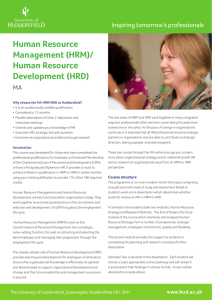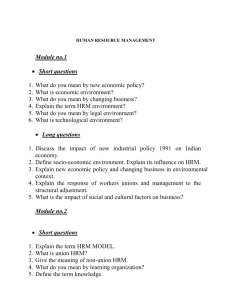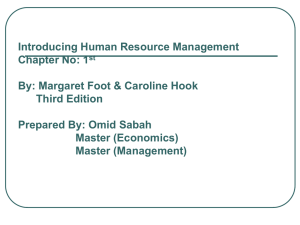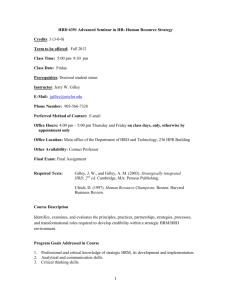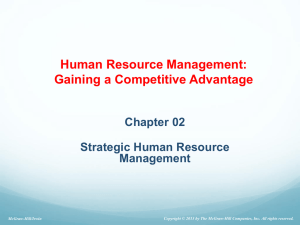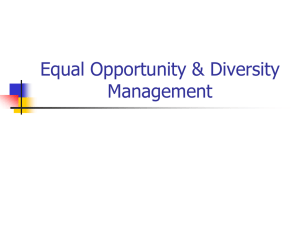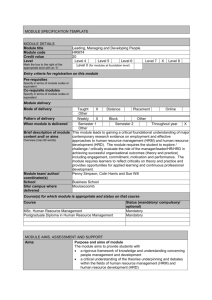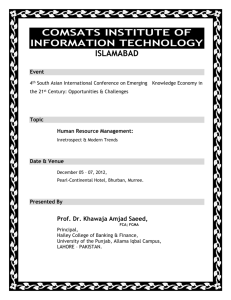File
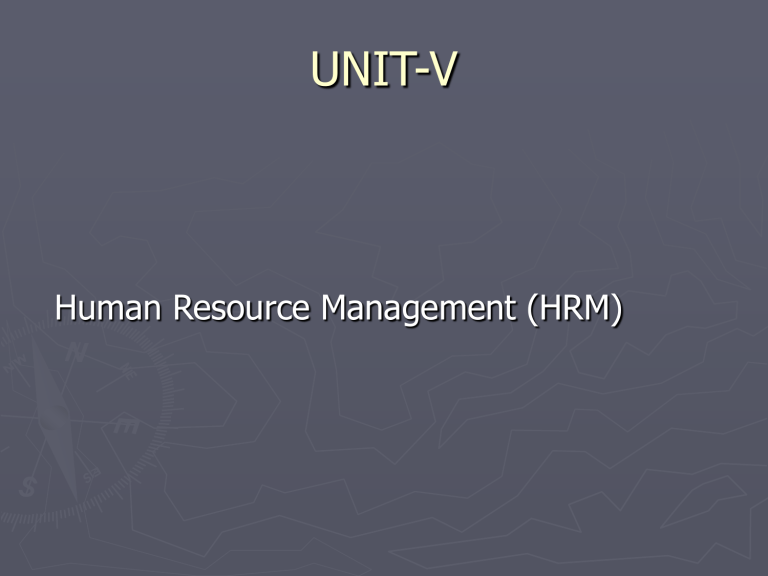
UNIT-V
Human Resource Management (HRM)
3.
4.
5.
6.
1.
2.
7.
8.
INDEX
UNIT 5 PPT SLIDES
S.NO. TOPIC
Human Resources Management HRM
Concepts of HRM, HRD and Personnel Management
Industrial Relation ( PMIR), HRM vs PMIR
Basic functions of HR Manager: Manpower planning
Recruitment, Selection, Training and Development
Placement, Wage and Salary Administration
Promotion, Transfer, Separation, Performance Appraisal
Grievance Handling and Welfare Administration
LECTURE NO.
L4
L5
L6
L7
L8
L1
L2
L3
Definition of HRM:-
►
Dale Yoder – “The Management of human resources is viewed as a system in which participants seek to attain both individual and group goals.”
►
Flippo – HRM “ is the Planning, organizing, directing and controlling of the procurement, development ,compensation, integration, maintenance and reproduction of human resources to the end that individual, organizational and societal objectives are accomplished”.
Concepts of HRM:-
►
Employment
►
Selection and training
►
Employee services
►
Wages
►
Industrial relations
►
Health and safety &
►
Education
Functions of personnel Mgt:-
Operative functions
Procurement
Development
Compensation
Maintaining
Managerial functions
Planning
Organizing
Co-ordination
Directing
Motivating
Controlling
Human Resource Development:-
►
HRD is the process by which the employees of an organization are helped in a continuous and planned way to develop their capabilities.
Difference btw HRM & HRD:-
►
►
►
►
HRM is a routine function.
Independent one.
Exclusive responsibility of personnel dept.
It considers salary, economic rewards, job simplification as important motivators.
►
►
►
►
HRD is a continuous development function.
HRD is a sub-system.
Aims at developing the capabilities of all its managers.
It considers informal work groups, job enrichment, as main motivators.
Basic Functions of Manager:-
►
From the stage of identifying the manpower requirements to the stage of ensuring that the employees contribute to the corporate goals, the personnel manager has to look after all the functions.
►
In this process of job analysis, job description and job specification assist the personnel manager at every stage.
Manpower planning:-
Definition:- Manpower planning is defined as a rational method of assessing the requirements of human resources at different levels in the organization. It ends with proposals for recruitment, retention, or even dismissed.
Recruitment:-
►
Recruitment is often called a positive function because the applications are invited as this stage for further scrutiny and short listing.
►
Sources of recruitment include: internet, execuite search agencies (head-hunters), advertisements in the media including TV and radio, employment exchanges, university and college campuses, technical and trade journals….
Selection:-
►
The process of identifying the most suitable persons for the organization is called selection.
►
Selection is called a negative function because at this stage the applications are screened and short listed on the basis of the selection criteria.
Stages in selection process:-
►
Initial screening/ short listing
►
Comprehensive application/ bio data screening
►
Aptitude or written tests
►
Group discussion
►
Personal interview
►
Medical examination
►
Employment offer
Training and Development:-
►
1.
2.
►
►
Training and development are essential for achieving organizational goals.
Development is an activity aimed at career growth rather than immediate performance
Training methods:- 2 types
On the job training
Off the job training
On the job training:-
Learning by physically doing the work
►
Job instruction training
►
Experiential training
►
Demonstration
►
Apprentice training
Off the job training:-
Provide a relatively broad idea relating to a given job or task.
►
►
►
Lectures/tasks and class room instructions
Conferences
Seminars
►
►
►
►
►
►
Team discussions
Case study
Role-playing
Programmed instructions
Simulation exercises
Group decision making
Placement:-
►
After training, the employee is placed in position under the charge of manager. The new recruit is allowed to exercise full authority and is held responsible for the results.
Wage and Salary Administration:-
►
Wage and salary administration is the process of fixing wage/ salary for different jobs in the organization through job evaluation , negotiations with the unions.
Promotion, Transfer, Separation:-
Promotion:-refers to the advancement of an employee to a job with a higher authority and responsibility.
Transfer:-moves an individual employee from one position to another.
Separation:-refers to termination of employment. The employee is separated from his job.
Performance appraisal:-
Definition:- is the process of measuring and evaluating the performance or accomplishments including individual behavior, of an employee on the job front for a given period.
►
Who will appraise: supervisors, peers, subordinates, managers by themselves, users of services, consultants.
Grievance Handling:-
►
Grievance is any dissatisfaction or feeling of injustice in connection with one’s employment situation that is brought to the attention of management.
►
A grievance is traceable to perceived nonfulfillment of one expectations from the organization.
Welfare Administration:-
►
The payment of wages act,1936
►
The minimum wages act, 1948
►
The workmen’s compensation act, 1923
►
The employee state insurance act,1948
►
The employee provident fund act,1952
Job evaluation:-
Definition:-Is the technique of assessing systematically the relative worth of each job.
Methods of Job evaluation:-2 types
1.
►
Non-quantitative methods
Ranking method
►
Job classification or Grading method
2. Quantitative methods
►
► points rating method
Factors comparison method
Merit rating:-
►
Is the process of evaluating the relative merit of the person on a given job.
Objectives:-
►
To determine salary increments
►
Decide who has to be transferred, promoted, or demoted.
►
To enhance employee morale.
►
To guide and monitor the performance of those who are lagging behind
Methods of Merit Rating
►
Ranking method
►
Paired comparison method
►
Rating scale
►
Forced distribution method
►
Narrative or essay method
►
Management by objectives (MBO)



